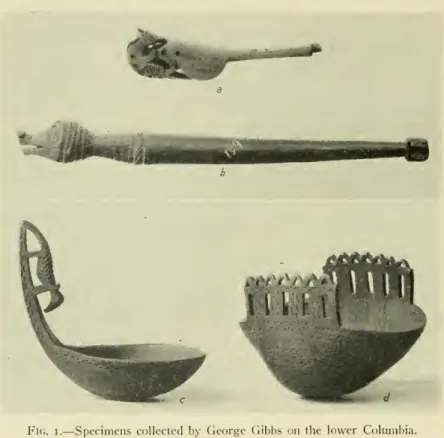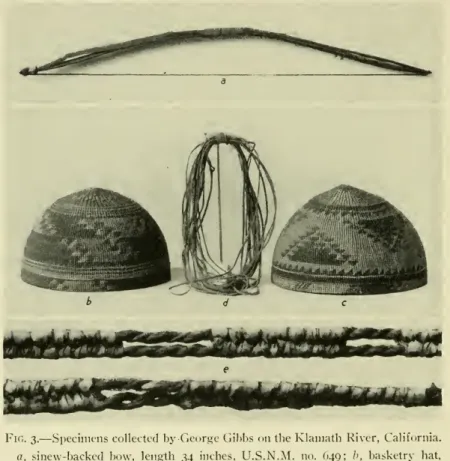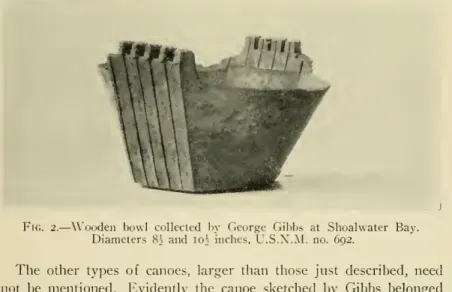Willamette Valley tribal chiefs, viz. a tribe at the falls of the Willamette, probably Clowwewalla. The Far West now became interesting and the mystery of the wilderness attracted many. In 1851 he was a member of the McKee party and visited the northwestern part of California.
During the journey he learned much about the various native tribes with whom he came into contact, especially those ... he encountered in the Klamath Valley. Although Gil:)bs was primarily interested in language studies, he collected ethnological material, much of which has been preserved in the collections of the National Museum. On September 22, Gil)bs made a sketch of the Columliia from the mouth of the Deschutes River.
6 SMITHSONIAN MISCELLANEOUS COLLECTIONS VOL. 97 the ground is not known, but as so little has lieen recorded concerning
The Chinookan tribes, who occupied both banks of the lower Columbia, excelled in carving wood and bone. The narrative of the expedition refers to the skill of the natives in the manufacture of many articles which they used in and about their houses, described as "large wooden buildings, varying from twenty to sixty feet in length, and from fourteen to twenty in breadth." The. Later, when the expedition was at the village of Cathlamah, also on the Columbia and not far from the Clatsops, some of the customs of the people were recorded in the narrative (p. 493).
Fine examples of the work of the people near the mouth of the Columbia are shown in Figure i. The Ninth of the Colunihia is shown in Figure 2. Similar pieces The Ninth of the Colunihia is shown in Figure 2. Similar pieces were undoubtedly seen by Lewis and Clark a generation earlier. Accordingly, on the Columbia we have seen canoes of many forms, beginning with the simple boats near the mountains, up to the more highly ornamented boats, as they were more useful nearer the mouth of the Columbia.

OREGON, 1851
8 DRAWINGS BY GEORGE GIBUS BUSHNELL 9 many of the relations between the different tribes are conducted by water, most of the relations between the different tribes are conducted by water, the ingenuity of the people would naturally be directed to the improvement of canoes, contradictory, contradictory. ,anelegantornament. 34;Gentlemen: I li;iv<.' ])vvu was formally notified to yonr ;i])])ointnicnl as 'Neyotial treaty commissioners with several Inchan trihs in Oregon Territory, for the extinguishment of their claims to the lands lying west of the Cascade Mountains, under the act of June 5 last'; and I am addressed by the Hon. The Secretary of the Interior to prepare appropriate instructions for your compliance in the performance of the duties of your office".
34. A treaty concluded on the 16th instant with the Santian band of the Callapooya tribe of Indians, by which they cede to the United States a portion of the valley of the Willamette, about eighty miles in length and about twenty in breadth. And also a treaty made this day, with the Twallalty gang of the same tribe, including a country about fifty miles in length and about thirty in breadth. Among the Gibbs materials in the Bureau of/Vmerican Ethnology, Smithsonian Institution, is a manuscript indicating where and when he compiled many of the vocabularies.
It is of the Si-yam-il, or as commonly called the Yamhill gang, who live on the river of that name, which empties into the Willamet from the coast region. This was received from an Indian of the .. band living on the upper waters of the Santiam. Portrait sketches of two chiefs are given in ])latc 7, one of a chief of Santiani l)an(l of Callapooyas, Init not one.
Slacum may have been a leader of the Clowwewalla, belonging to the Chinookan family, a tribe that occupied the region adjacent to the Willamette River Falls, the location of Oregon City. This tribe, now almost extinct, was formerly very numerous, and lives near the falls of the river, twenty-five miles from its mouth, on the right bank. The oak and ash trees are covered in this season with long moss, of a sage green, which contrasts nicely with the deeper shades of the evergreens.
Gibbs appreciated the beauty of the region and revealed it in two sketches reproduced on Plate 8.
12 SMITHSONIAN MISCELLANEOUS COLLECTIONS VOL. 97
NU. 8 DRAWINGS BY GEORGE GIBBS BUSHNELL I3
IN NORTHWESTERN CALIFORNIA, 1851
It is. a valuable account of a journey through i) the art of a country which has never before been carefully studied, and gives a brief account of the native inhabitants of a rugged, mountainous region, which f) occupies secluded valleys near rivers, which are often difficult to discover. Pencil sketches made by Gibbs of scenes along the route reveal .. much of interest and beauty in the wilderness and are .. now reproduced for the first time. Journal statements describing or explaining drawings will be cited, although they must be mostly of equal value, but not relating to sketches, necessarily omitted.
Journal ok the expedition of Colonel Redick M'Kee, United States Indian Agent, through northwestern California. By George Gibbs. Today Ai((/. 11. — Colonel M'Kce and party, escorted by Major Wessells, . and a detachment of thirty-five nionnted riflemen, left Sonoma this morning and moved over to .Santa Rosa, The general route proposed to be followed of the expedition, was up the Russian River to its sources, down the Eel River to Humboldt Bay, and thence over to the Klamath, ascending to the neighborhood of the Shaste Valley, if the season permits.[PI.
Large groups of Indians assembled and a treaty was made. "In personal appearance many of the Clear Lake Indians are of a very degraded caste; their foreheads, of course, are often as low as the compressed skulls of the Chinooks. We obtained a vocabulary of this language from an Indian who accompanied us, and who spoke Spanish well enough to interpret with its])people.” This valley is surrounded on all sides by mountains, and is completely isolated from the neighboring country, as there is no access except by difficult paths.
The main valley on the lake is that on which we encamped, situated on the west side and extending from Mount Af'Kce to the kop. The extent of this may be stated as ten miles in length, with an average breadth of four. Schoolcraft, Henry R., Information Concerning the History, Condition, and Prospects of the Indian Tribes of the United States, pt.
8 DRAWINGS BV GEORGE GIBBS BUSHNELL I5grass, and interspersed with groves of beautiful oaks of the most diverse and.
NO. 8 DRAWINGS BV GEORGE GIBBS BUSHNELL I5 grass, and interspersed with groves of superb oaks of the most varied and
They had also, hanging round their necks, small nets, neatly made after the fashion of the common game bag; twine, which was very even, was certainly their work. I tried in vain to get from them the names of articles in the hand, parts of the body, &c., as they either could not or would not understand the object of the inquiry; nor was our Clear Lake Indian more successful after his method.

NO. 8 DRAWINGS BY GEORGE GIBBS BUSH NELL 1/
They are not so skilled in preparing dressed skins as the Oregon Indians, and the use of double-dressed ones is confined chiefly to women. On the morning of October 9, the expedition left the mouth of the Trinity and proceeded up the Klamath Valley. They still make a kind of bread from the oak flour, which they bake in the ashes.
On the other side of the river was an Indian village, Sehe-perrh: the first that belonged. The party camped on the banks of the Klamath about a mile above the mouth of the Salmon River, and there remained from the after-. The tree to the right of the latter represents one of the signal or "telegraph trees" of the Klamath Indians.
These, which are among the most conspicuous features of the riverside landscape, occur near every village. Two trees, one trimmed in the form of a cross, the other with a mere tassel on top, represent each lodge; and in time of danger or death, lighting a fire under them, they inform the neighboring tribes of the necessity or misfortune of it. Scott's Valley, with "the snowy summit of Shaste lying to the southeast and towering above all," was reached on the afternoon of October 21st.
On the day of October 26 he rode to Shaste Butte City, about twenty-five miles from camp, and the next morning. Members of the party, including Gibbs, started from Scott's valley camp at noon on November 6 to return to San Francisco. They went over the same trail to their old camp on the Klamath, near the mouth of the Salmon, where they arrived on the 12th.
We found the Indians of the village burnt, rebuilding their houses for the winter.
VIEWS IN THE VALUEY OF THE KLAMATH
NO. 8 DRAWINGS BY GEORGE GIBBS BUSH NELL 21 After encountering many difficulties and delays, Gibbs arrived
22 SMITHSONIAN MISCELLANEOUS COLLECTIONS VOL. 97
CALIFORNIA, 1851
NO. 8 DRAWINGS BY GEORGE GIBBS BUSHNELL 23 At present I can form no satisfactory estimate of the amount of appropriations
24 SMITHSOXIAN MISCELLANEOUS COLLECTIONS VOL. 97
8 THE DRAWINGS OF GEORGE GIBBS BUSHNELL 25 a different dialect is spoken, but in such a way that it is understood by different people. The Indians here are a very handsome race, short in stature, with smooth, regular features. On the 6th of October a treaty was made with a number of bands of Indians, who assembled for the purpose at the junction of the Klamath and Trinity rivers, and that night presented gifts of blankets, shirts, trousers, beads, shawls, handkerchiefs, &c. &c., were distributed by the light of great fires; but then the Indians all separated for the night, very pleased.” Among the bands present that day was the “Wetch-peck band,” in which was Alec-ug-gra.
A sketch made at that time shows a small Indian camp in the bend of the river. 34; Sir: Please note below a memorandum of articles which I would recommend to be purchased for presents to be distributed among the Indians of California. It will be well to make the purchases in New York, as it is quite uncertain whether Mr.
34; It will be necessary for the packages to be made up to a weight of approx. 200 lbs. and well fixed in wax cloth, to prevent damage to the contents, as it is now the rainy season."
NO. 8 DRAWINGS BY GEORGE GIBBS BUSHNELL 27


